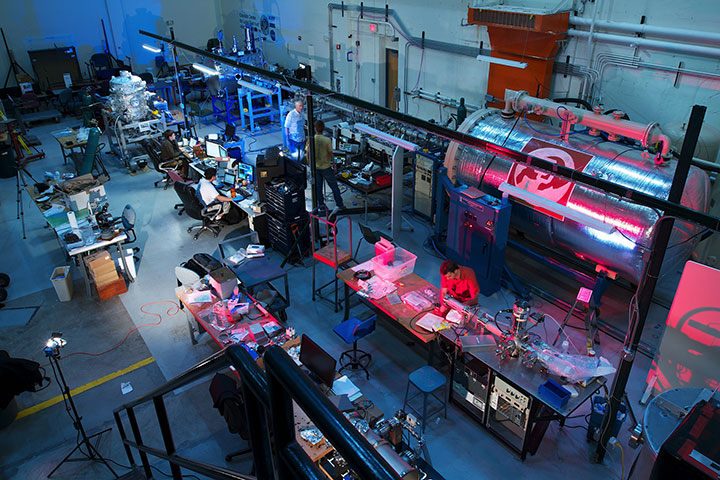 File image shows the inside of a research institute at LASP dedicated to studying plasma and dust in the solar system. (Source: LASP)
File image shows the inside of a research institute at LASP dedicated to studying plasma and dust in the solar system. (Source: LASP)
Constellations spoke with Spencer Boyajian, professional research assistant at the Laboratory for Atmospheric and Space Physics, commonly referred to as LASP, at the University of Colorado, Boulder. Boyajian described LASP’s journey from university project to international satellite program.
“LASP predates NASA, actually. It originally started as the Upper Air Laboratory because we weren’t quite to space just yet,” said Boyajian, “and then started with sounding rockets, putting science payloads on sounding rockets, heliophysics, paving the way for some ADCS [attitude determination and control systems that determine a spacecraft’s orientation in orbit] pointing on top of sounding rockets as well. Some really, really cool history.” Boyajian added that LASP did a lot of work with the U.S. Navy and Air Force shortly after World War II, launching science payloads on captured German V2s in the White Sands Missile Range.
He explained that, more recently, LASP has “been taking in the capability to do full spacecraft as well, not just instruments.” He explained further that “this is for NASA or other space organizations, like the Emirate Space Program. Basically, a total end-to-end design, build and test and operation facility.”
International Collaboration
Boyajian was eager to discuss INSPIRE, the International Satellite Program in Research and Education, one of LASP’s leading initiatives that aims to provide hands-on experience for students to design, build, and operate satellites. According to Boyajian, INSPIRE was emboldened by the success of the Colorado Student Space Weather Experiment (CSSWE), which was funded by the National Science Foundation.
“For the lab, that really proved that CubeSats could do science and train students.” After the success of CSSWE and another CU student project, MinXSS, Boyajian said that they wanted “to try and make [INSPIRE] an international program to train students and capacity-build. And so, we looked at how we ran things internally. We wanted to try and export this style. How can you use that on an internationally collaborative mission?”
To answer the question LASP held a gathering of international universities, including the University of Colorado, the Indian Institute of Space Science and Technology and the National Central University in Taiwan. This was the core group that established INSPIRE, he explained.
The Culture Barrier
Funding INSPIRE was an initial hurdle, but one of the biggest challenges, according to Boyajian, was the language barrier. “Different cultures, having students that maybe have never worked internationally before, a big hurdle to face, getting visas for students to travel,” were just some of the issues to be dealt with. “Every year,” Boyajian continued, “we did a summer program in Boulder, a meetup and workshop together. And so, getting visas for that was extremely important.”
INSPIRE’s First CubeSat
One of the first outputs from the group was preliminary design work on their first CubeSat, IS-1, that carried two payloads: the Compact Ionosphere Probe (CIP) and the Dual Aperture X-ray Solar Spectrometer (DAXSS). These instruments aim to improve the understanding of the ionosphere and solar activities, respectively. As Boyajian explained: “Examining the midnight temperature maximum in the ionosphere, the turnover and seeding of activity in the ionosphere every day—it’s the number one source of GPS ranging errors.” He continued that the overall objective for IS-1 was to obtain a “better understanding and modeling” of the ionosphere weather, and through that develop an “increase in accuracy in GPS systems.”
Boyajian further explained that they were fortunate to add DAXSS, the dual aperture X-ray solar spectrometer, to the payload as it measured the soft X-rays around the sun. Boyajian described how these are very hard to observe since they are the “dullest light in the X-ray coming off the sun.”
Having Your Own Ground Station Is Perfect, but…
When the conversation segued to how LASP tracked its satellites, Boyajian described LASP’s ground station. “We have a UHF [Ultra High Frequency] ground station, S-band and between those two, we’re usually able to operate the challenges all our spacecraft. If we need X-band, then we will go out to a servicer, AWS or KSAT, similarly.” He explained further that it’s extremely useful to make first contact with your satellite shortly after launch. Instead of having to wait for a pass over your own ground station, you can see your own packets coming down into someone else’s ground station. “And so,” he concluded “having your own ground station is perfect, but being able to look for your satellite with others’ ground stations is a big pro.”
Being a Part of Scientific Discovery
Boyajian was asked to describe what transformative scientific discoveries LASP has been a part of. In response he said that the one that stuck with him was the Upper Atmosphere Research Satellite (UARS). “I feel like it was a hot topic …and it helped scientists understand the energy input, chemistry and dynamics of the upper atmosphere. It was one of the missions that confirmed the hypothesis and role of chlorofluorocarbons in ozone depletion and clarified chemical processes that can cause that Antarctic ozone hole.”
To hear more about 12U Satellites, dual aperture X-ray solar spectrometers and the challenges of international collaboration click here.
